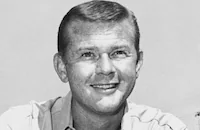The Wreck of the Hesperus
Cast & Crew
John Hoffman
Willard Parker
Edgar Buchanan
Patricia White
Holmes Herbert
Wilton Graff
Film Details
Technical Specs

Synopsis
In the year 1830, after crashing his ship, the Sudan , on the rocks off the coast of Maine, Captain John McReady is blackballed by the ship's owners, and thus cannot find work. Unknown to John, the ship was deliberately guided onto the rocks by men working for George Lockhart, a wealthy Bostonian who owns a crooked salvage business. By misplacing lanterns that are intended to guide night-sailing ships into channels, Lockhart causes shipwrecks and reaps large profits from their salvage. While recovering from his shipwreck, McReady is visited by Lockhart, who capitalizes on the captain's resentment towards the shipowners and offers him a job at his salvage company. Later, in Gloucester, Massachusetts, an effort by townspeople to have a lighthouse built at the dangerous Norman's Woe point is quickly undermined by the efforts of Lockhart and his accomplices, Joshua Hill and Ned Jones. Soon after Lockhart instructs Joshua and Ned to arrange for the shipwreck of another ship, McReady arrives in Gloucester. News of the latest shipwreck, that of the Hesperus . is spread by tolling bells, and McReady immediately goes to work. During a public auction of the salvage in Gloucester, McReady's fiancée, Deborah Allen, calls the men in the salvaging business "scavengers" and implores him to quit the business. Although he rejects her pleas, McReady soon begins to question the operation when he discovers that his brother Angus and his niece Lucy were among the victims of the shipwreck. Grief stricken, McReady goes to the scene of the wreck, where he discovers one of Lockhart's lanterns. Furious, the captain accuses Lockhart of sinking the Hesperus and the Sudan , and in the ensuing struggle, Lockhart shoots McReady in the arm. Lockhart then orders the captain to keep quiet about the incident and threatens to frame him for the shipwrecks if he talks. McReady remains silent about the shooting, but he makes a public apology to the people of Gloucester for initially opposing the building of the lighthouse at Norman's Woe. Now leading the effort to get the lighthouse built, McReady runs into trouble with Lockhart's men, who try to scare off the crusading captain and others. Soon after securing a high-ranking government appointment from Governor Lincoln, Lockhart orders the imprisonment of McReady. McReady later attempts an escape with the help of his pals, who have started a fire as a diversion, but he is caught while trying to flee by mail coach. Deborah, however, who was riding in the mail coach with him, continues to the governor's residence and tells the truth about McReady and Lockhart. After McReady is set free by order of the governor, he and others set a trap for Lockhart at the breakers. There Ned and Joshua are caught hiding their lamps, after which McReady successfully overpowers Lockhart. With Lockhart and his henchmen put away, McReady joins Deborah and the other townspeople at the commemoration of the new lighthouse at Norman's Woe.

Director
John Hoffman
Cast

Willard Parker

Edgar Buchanan

Patricia White

Holmes Herbert
Wilton Graff
Boyd Davis

Jeff Corey
Paul Campbell
Paul E. Burns
Trevor Bardette
Herbert Heywood
Earle S. Dewey
Mikel Conrad
Patti Brady

Martin Milner
Eddy Waller
Virginia Farmer
John Rice
Steve Clark
Ed. Peil Sr.
Al Thompson
Pat O'malley
Cy Malis
Edmund Cobb
Jerry Hunter
Allan Ray
Victor Travers
Vernon Cansino

Bob Wilke
Heinie Conklin
Paul Conrad
J. Louis Johnson
Budd Buster

Chester Conklin
Frank O'connor
George Morrell
Gil Patric
Al Herman
Ralph Volkie
Bob Cason
Kit Carson
Larry Law
Crew
Mischa Bakaleinikoff
Milton Feldman
Stephen Goossón
Edward Huebsch
Wallace Macdonald
Wilbur Menefee
Robert Peterson
Allen Siegler
James Sweeney
Frank [a.] Tuttle
Aubrey Wisberg

Film Details
Technical Specs

Quotes
Trivia
Notes
Although a February 1946 Daily Variety news item noted that Michel Kraike was set to produce the film under the executive supervision of Bennie F. Zeidman, the film credits only Wallace MacDonald as the producer. Some filming took place in Laguna Beach, CA. Other films based on Henry Wadsworth Longfellow's poem include a 1926 British short, the 1927 Paramount film The Wreck of the Hesperus, directed by Elmer Clifton and starring Sam De Grasse and Virginia Bradford (see AFI Catalog of Feature Films, 1921-30; F2.6544), and a 1944 Twentieth Century-Fox Mighty Mouse cartoon short directed by Mannie Davis.












